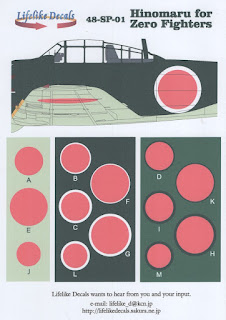Lifelike Decals Set 48-062 Part 2 is the second of two recently released sets of beautifully printed decals for Mitsubishi A6M Zero fighters in 1/48 scale (and more Zero sets are planned and being prepared). This set contains markings for 13 subjects of different variants, including an A6M2-K two-seat trainer and two A6M2-N 'Rufe' floatplane fighters. It also includes the comprehensive notes as provided in 48-061 and the sheet of Hinomaru decals 48-SP-01 for which the previous comments also apply.
The subjects in this second set, shown above, are as follows:-
- A6M2 Type 21 'X-183' as flown by PO 2/c Yoshiro Hashiguchi of 3 Ku from Kendari in February 1942; in overall grey-green, depicted with a blue fuselage band, white tail stripe and 11 cherry blossom kill marks on tail fin.
- A6M2 Type 21 'V-117' as flown by Lt Masuzo Seto of Tainan Ku from Balikpapan or Denpasar, Bali during January and February 1942; in overall grey-green, depicted with two blue fuselage bands and red tail stripes above and below the tail code. This well known aircraft has been depicted with various colour combinations for the fuselage bands and tail stripes but the caption presents the sound reasoning for the choice of colours in this set.
- A6M2 Type 21 '81-1146' of 381 Ku flown from Sorong airfield on Efman (or Jefman) Island in May 1944; in dark green over grey with theatre markings of grey painted tail fin and wing tips. white cowling front and white fin stripe, speculated as command markings. This aircraft has been previously depicted with various garish cowling front and tail fin colours but Lifelike set the record straight. The airfield was known as 'Sorong' to the Japanese even though the town and harbour of that name were across the sea to the east of the island on the north-western tip of New Guinea also incorporating a seaplane base.
- A6M2 Type 21 'EI-111' as flown by Lt Hideki Shingo of Shokaku Fighter Group during the Battle of Santa Cruz on 26 October 1942; in overall grey-green with white fuselageband and three white tail stripes, all outlined red.
- A6M2 Type 21 '虎-143' (Tora - Tiger-143) of 261 Ku flown from Kagoshima from end of 1943 to early 1944; in dark green over grey with white fuselage bands, tail stripe and wing stripes. Although the caption describes the spinner as speculatively depicted as dark brown the accompanying profile depicts a dark green spinner.
- A6M2 Type 21 '雷-134' (Rai - Thunder-134) of 265 Ku flown from Xinzhu (Hsinchu), Taiwan at the beginning of 1944; in dark green over grey with yellow lightning flash across tail fin and rudder and red tail code outlined in white.
- A6M3 Type 22 '191' as flown by Lt jg Usaburo Suzuki of 582 Ku from Buin on 7 April 1944; in field applied dark green over grey leaving some parts of the upper surfaces uncamouflaged, with two yellow fuselage chevrons and red tail code outlined white. The code '191' is speculative.
- A6M3 Type 22 '173' as flown by Lt Cdr Saburo Shindo from Buin on 16 June 1944; in factory applied dark green over grey with two yellow fuselage chevrons and red tail code 173 outlined white. Two pairs of fuselage chevrons are included for this and the previous subject with slightly different yellow hues.
- A6M2 Type 21 '81-1138' of 381 Ku flown from Sorong airfield on Efman (or Jefman) Island, Western New Guinea in May 1944; in dark green over grey with theatre markings of grey painted tail fin and wing tips, but differenced from subject # 3 by a non standard Houkoku-type marking in white on the rear fuselage. This aircraft is noted as carrying air-to-air bombs under its wings.
- A6M2-K 'ツ-415' (Tu-415) of Tsukuba Ku flown from Misawa, Aomori Prefecture, Japan during September 1944; in dark green over orange yellow with yellow painted upper fin and rudder. Although the caption describes the spinner as speculatively depicted dark brown the accompanying profile depicts aluminium.
- A6M2 Type 21 'BII-124' as flown by NAP 1/c Hajime Toyoshima of Hiryu Fighter Group, and force landed on Melville Island on 19 February 1942; in overall grey-green with two blue fuselage bands and blue tail stripe.
- A6M2-N '34-116' of 934 Ku flown from Halong seaplane base on Ambon Island in March 1943; in dark green over grey with yellow lightning flash insignia on fuselage. The white borders of the Hinomaru have been overpainted on this aircraft. Ambon was part of the Molucca Island group in the Banda sea between Sulawesi and western New Guinea.
- A6M2-N '934-06' as flown by PO 1/c Hidenori Matsunaga of 934 Ku from Halong, Ambon Island from March 1943 to April 1944; in dark green over grey with yellow lightning flash insignia on fuselage. Although the caption shows '934-116' this is a different aircraft to subject # 12 and the profile and decals are correctly shown and printed as '934-06'.
Again the chosen subjects in the 48-062 set are excellent, presenting a variety of colourful schemes and markings with the usual Lifelike attention to detail. The comprehensive notes included are an added bonus. The decals, printed for Lifelike by Microscale Industries in the USA, are sharply printed to a gloss finish with bright colours and strong saturation. It should be mentioned that both sets 48-061 and 48-062 include stencils and positional schematics for them (as shown below). Recommended kits are Eduard, Hasegawa or Tamiya for the A6M2 and A6M2-N, Eduard or Tamiya for the A6M3 Type 22, and Hasegawa for the A6M2-K, so this is an excellent set for finishing any older kits in the stash. What a pity that the A6M2-K trainer is not better represented in available 1/48 and 1/72 kits! Again this set is highly recommended.
With special thanks to Keishiro Nagao of Lifelike Decals for the review samples and the work put into presenting this set.
Image credit: All © 2023 Lifelike Decals








































